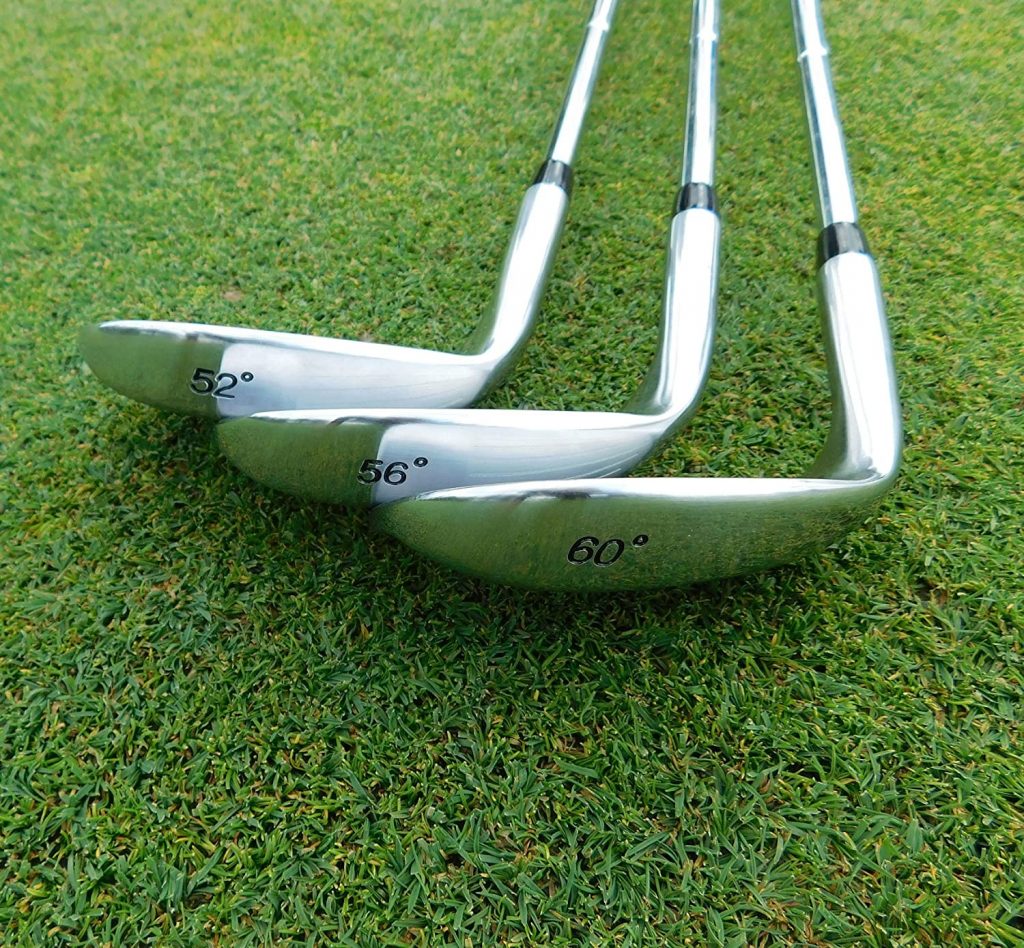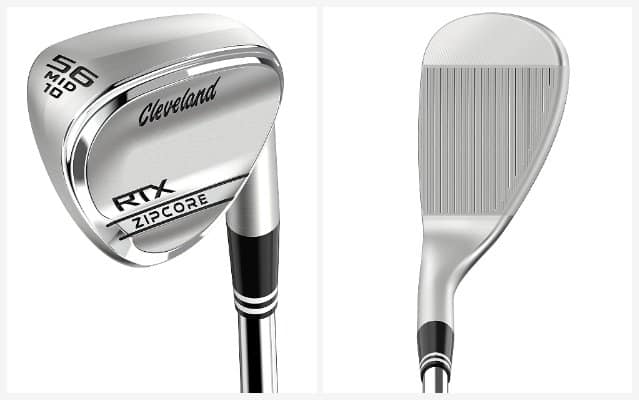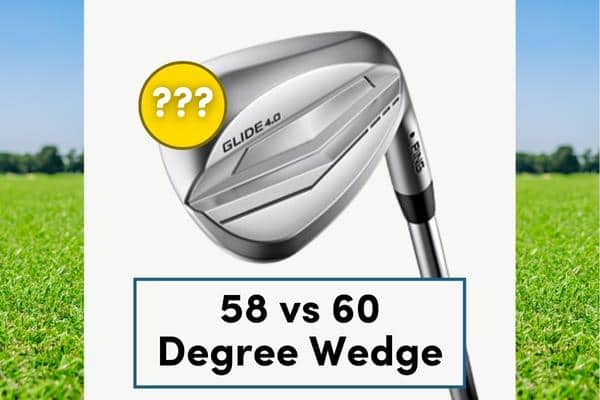If you’re looking to add a lob wedge to your bag, chances are you’ll need to decide between one that has either 58 or 60 degrees of loft.
Sure, some of the pros have 64 degree wedges in their bag (think Phil Mickelson, for example), but for the average golfer it’s likely your lob wedge will be stamped with the number 58 or 60.
So, how do you choose between a 58 or 60 degree wedge?
Your lob wedge should have 58 degrees of loft if you already use a 50 degree gap wedge and 54 degree sand wedge. This will guarantee consistent gapping between clubs. Likewise, your lob wedge should be 60 degrees if you use a 52 degree gap wedge and 56 degree sand wedge.
As I mentioned in more detail in another article, the loft of your lob wedge will largely be determined by your gapping requirements – which is dictated by the other clubs in your bag.
Increasing each wedge by four degrees will usually give you similar carry distances between each club, meaning you’re able to hit more full shots into greens from specific yardages rather than relying on hitting half or three-quarter shots to cover an awkward gap.
A common wedge set-up is as followed (based on the average male golfer’s distances):
- Pitching wedge: 46 degrees of loft (125 yards)
- Gap wedge: 50 degrees of loft (110 yards)
- Sand wedge: 54 degree of loft (95 yards)
- Lob wedge: 58 degrees of loft (80 yards)
Another suitable set-up might be similar, but slightly different:
- Pitching wedge: 48 degrees of loft (120 yards)
- Gap wedge: 52 degrees of loft (105 yards)
- Sand wedge: 56 degrees of loft (90 yards)
- Lob wedge: 60 degrees of loft (75 yards)
What you shouldn’t see is a difference of 6 degrees or more between your wedges as this is going to create inconsistent gaps in your yardages, meaning you’ll need to compensate by adjusting your swing speed on the course (which, for average players, is not an easy thing to do).
Personally, I use the second set-up, with my wedges being 48, 52, 56 and 60 degrees as I find this gives me the best, most reliable gapping related to my short irons.
Keep reading to learn more about the differences between 58 and 60 degree wedges, including what bounce you should use with them and, ultimately, which one is best suited to your game.
Table of contents
Is it better to use a 58 or 60 degree wedge?
Whether to use a 58 or 60 degree wedge will depend on the loft of your sand wedge. If your sand wedge has 54 degrees of loft, then it’s best to use a 58 degree lob wedge. If your gap wedge has 56 degrees of loft, then you should use a 60 degree lob wedge.
In terms of performance, there is very little difference between a 58 or 60 degree wedge – essentially, one flies around 5-10 yards farther than the other.
However, that 5-10 yards could be the difference between hitting the middle of the green or coming up short if you haven’t selected the correct lob wedge loft that suits your gapping.
Whether or not it’s better to use a 58 or 60 degree wedge, ultimately, comes down to your gapping requirements, as I explained above.
- If you use a 54 degree sand wedge, then it’s best to select a 58 degree lob wedge
- If you use a 56 degree sand wedge, then it’s best to select a 60 degree lob wedge
It really is that simple.
If you struggle with your wedge play, I’d recommend you check out some of our other articles below:
- Stop It Dead: How To Put Backspin On Your Wedges In Golf
- 4 Best Golf Chipping Techniques (And How To Master Them)
- How To Chip Consistently In Golf (Decide To Go High Or Low)
- Chipping vs Pitching In Golf: The Key Differences Explained
What is a 58 degree wedge used for?
A 58 degree wedge is typically used as a lob wedge for playing high-lofted chip or pitch shots from within 60 yards of the green. Usually, golfers will add a 58 degree wedge to their bag if their gap wedge has 50 degrees of loft and sand wedge has 54 degrees of loft.
For many players, a 58 degree wedge will be the most lofted club in their bag, and this makes it equipped for a variety of scenarios:
- You can use it for full swings from the middle of the fairway, and get it to land soft and spin back towards the pin
- You can use it for pitch or chip shots that require you to fly the ball over obstacles, or stop it quickly upon landing
- You can even use it for bunker shots, where the sand may be a little firm and require less bounce to allow the clubhead to cut into the surface layer
A 58 degree wedge will be suitable for all of these shots, which is why it’s so important that you have one in your bag.
What is a 60 degree wedge used for?
A 60 degree wedge is generally used as a lob wedge for playing high-lofted chip or pitch shots from within 60 yards of the green. Typically, golfers will add a 60 degree wedge to their bag if their gap wedge has 52 degrees of loft and sand wedge has 56 degrees of loft.
There is very little difference between a 58 and 60 degree wedge in terms of what it can be used for.
It is suitable for full swings and approach shots that require height; for chips or pitch shots where a bump-and-run isn’t suitable; or for greenside bunker shots.
If you practice a lot with your 60 degree wedge, you’ll find it can become a deadly weapon around the greens as it allows you to impart maximum spin on the ball and get it to stop on a dime.
Having this control is one of the keys to consistently lowering your scores (and maybe even break 100 or break 90 for the first time, if you haven’t already).

How far should you hit a 58 degree wedge?
The average male golfer will hit their 58 degree wedge anywhere between 70-90 yards (64-82 metres), while female players will range between 45-55 yards (41-50 metres). Professional male players average around 105 yards (96 metres) with a 58 degree wedge, and female players 75 yards (68 metres).
Rarely do you want to be swinging out of your shoes with a 58 degree wedge, as this will hamper your ability to control trajectory, spin and direction.
While you may be able to extract a few extra yards out of your 58 degree wedge, most of the time it isn’t worth it – the better play is simply to club down, and swing easier.
You’ll be amazed how much better you strike the ball and will, more often than not, get improved results.
How far should you hit a 60 degree wedge?
Generally, a 60 degree wedge will travel around five yards less than a 58 degree wedge. This is anywhere between 65-85 yards (59-77 metres) for the average male golfer, and 40-60 yards (36-54 metres) for the average female golfer. Male pros will hit their 60 degree wedge around 100 yards (91 metres), and female players 70 yards (64 metres).
Again, wedge play is all about feel – and the harder you swing, the less feel and feedback you’re likely going to get.
When using a 60 degree wedge, you never want to swing harder than 100 percent – ideally, you don’t even want to exceed 90 percent.
Next time you’re at the range, practice hitting your 60 degree wedge different distances and you’ll soon find a swing speed that produces the best results in terms of flight and control, which you can then apply when out on the course.
What bounce should a 54 or 56 degree wedge have?
The standard bounce for 58 and 60 degree wedges is 8 degrees, which is most common for lob wedges. However, it can range anywhere between 4-10 degrees. Usually, 8 degrees of bounce strikes the right balance between the clubhead cutting through the turf and elevating the ball quickly.
Essentially, the more bounce your wedge has, the more it will ‘bounce’ off the ground as soon as it comes into contact with the surface.
Sand wedges, as I’ve explained in another article, will typically have between 10-14 degrees of bounce, as they need it to help elevate the ball quickly out of bunkers.
Lob wedges, by comparison, are typically used from the fairway or rough, meaning they need less bounce in order to slice through the turf easier – and prevent the clubhead bouncing into the back of the ball, causing a thin shot.
My lob wedge has 8 degrees of bounce, which I find to be the perfect amount – however, any number between 4-10 degrees should be fine.

What is the best 58 or 60 degree wedge to use?
Personally, my favourite 58 or 60 degree lob wedge is the Cleveland RTX ZipCore model. It is available in 50, 52, 54, 56, 58 and 60 degrees meaning you can get matching gap, sand and lob wedges to suit your required gapping.
As I’ve mentioned in previous articles regarding gap wedges and sand wedges, my top choice for a lob wedge – regardless of whether it’s one with 58 or 60 degrees – is the Cleveland RTX ZipCore wedge.
We’ve been using this model here at Project Golf Australia for a while, and love both the look and feel of these clubs.
They’re extremely forgiving without the bulkiness of a game improvement wedge, and allow you to impart as much spin as you want – giving you greater control over shots that you want to rip back towards the hole, or release and roll-out upon landing.
The Cleveland RTX ZipCore wedges come in almost every loft imaginable, meaning you can grab matching gap, sand and lob wedges for continuity.
However, if you’d rather explore your options, we’ve written a comprehensive review of the Best Wedges on the market at the moment – ranking our favourites from each main manufacturer, but also grading them based on spin, forgiveness, bunker ability, overall performance and value.
Final message
There’s no doubt you should have a lob wedge in your bag, but deciding on whether to buy one with 58 or 60 degrees of loft will be determined by the lofts of your other wedges.
If you currently game a 50 degree gap wedge and 54 degree sand wedge, then it makes sense to purchase a lob wedge with 58 degrees of loft to ensure consistent gapping.
Likewise, if your gap and sand wedges have a 52/56 split, then the logical decision would be to go with a 60 degree lob wedge.
The importance of correct gapping cannot be overstated, and getting it right will give you every chance of improving your wedge play on the course and hitting your yardages more consistently.


